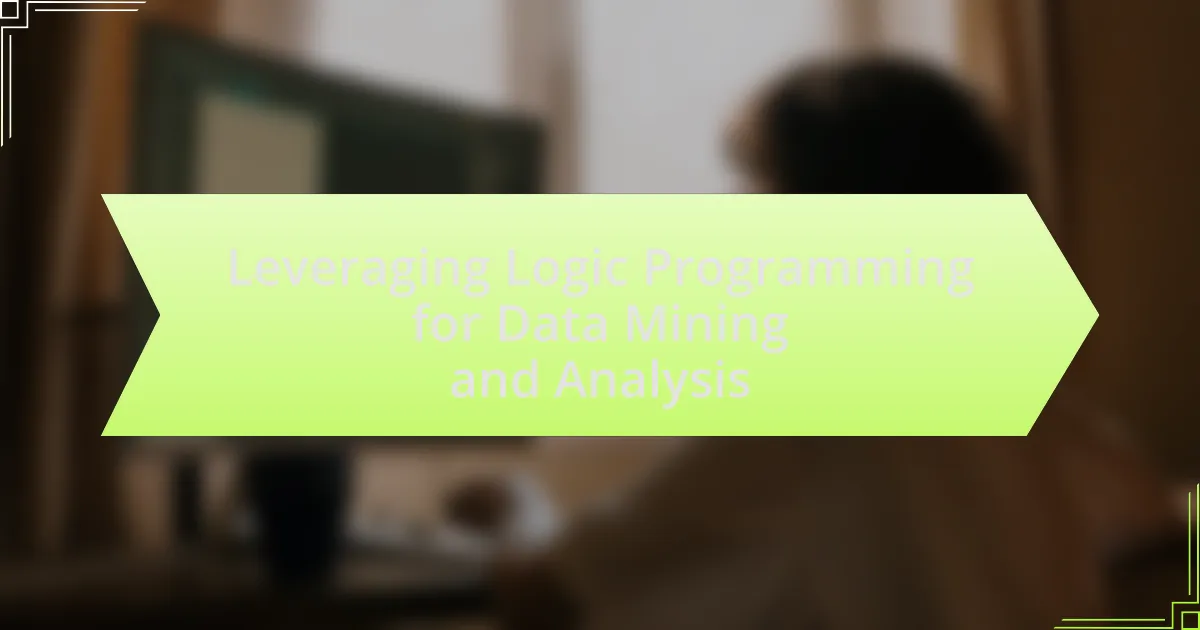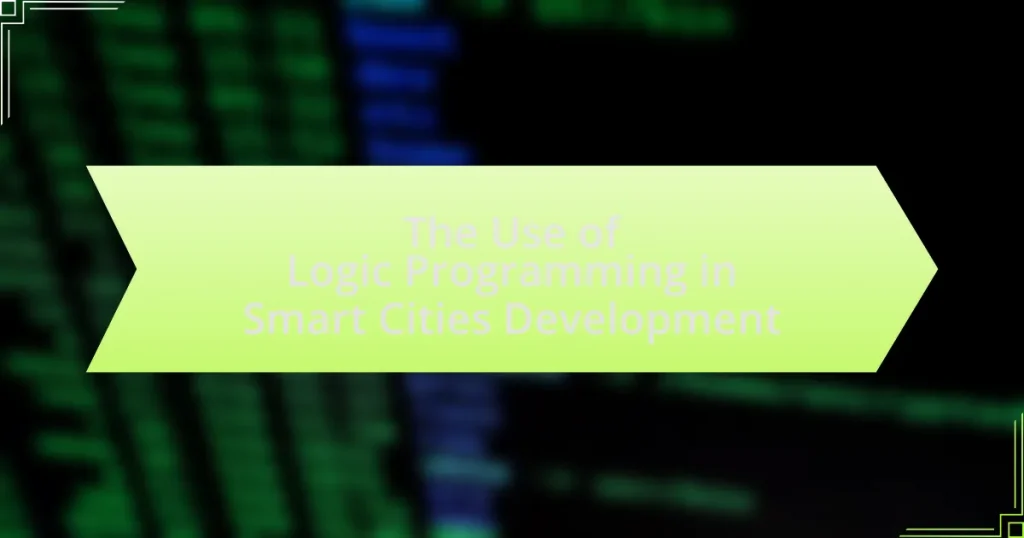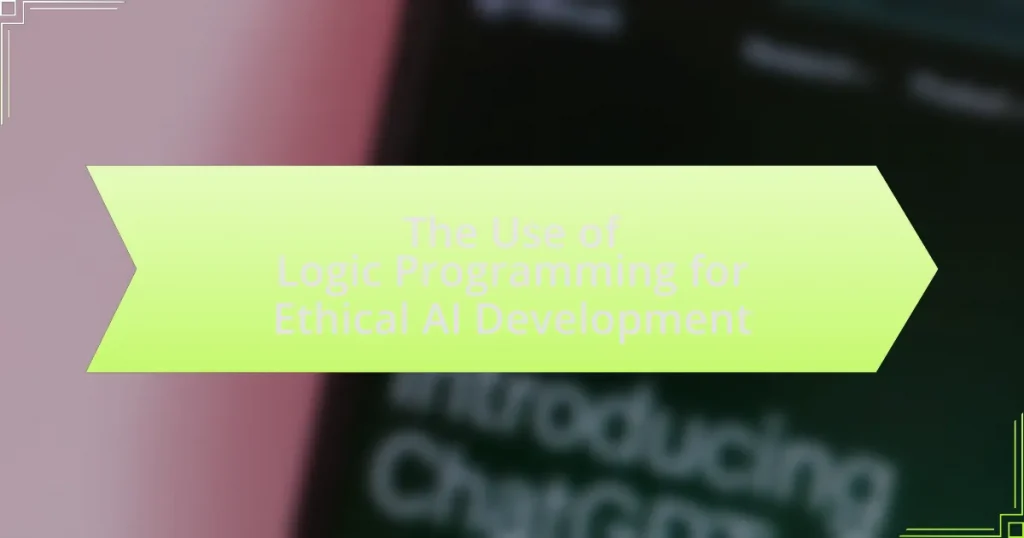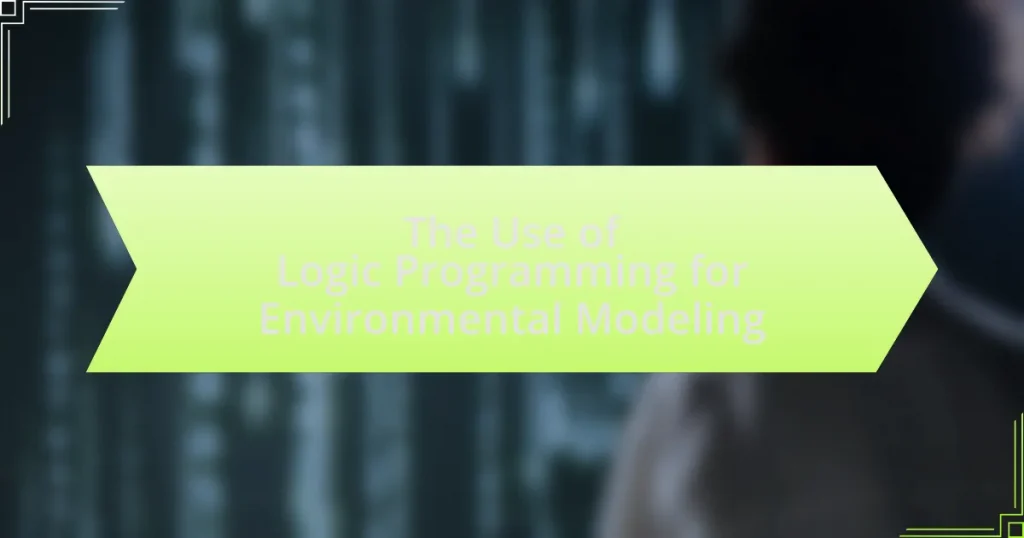Logic programming is a programming paradigm rooted in formal logic, providing a framework for representing and reasoning about data, which is essential for data mining. This article explores the relationship between logic programming and data mining, detailing how logic programming facilitates complex data analysis through declarative approaches, enabling efficient querying and inference. Key advantages include enhanced data representation, improved accuracy in data analysis, and the ability to handle uncertainty. The article also discusses specific techniques, emerging trends, and best practices for implementing logic programming in data mining projects, highlighting its potential to adapt to new data types and integrate with machine learning for more robust analytical capabilities.

What is Logic Programming and How is it Related to Data Mining?
Logic programming is a programming paradigm based on formal logic, where program statements express facts and rules about problems within a system of formal logic. It is closely related to data mining as it provides a framework for representing and reasoning about data, enabling the extraction of patterns and knowledge from large datasets. For instance, logic programming languages like Prolog facilitate the implementation of algorithms that can infer relationships and derive conclusions from data, which is essential in data mining tasks such as classification, clustering, and association rule learning. This relationship is evidenced by the use of logic-based approaches in various data mining applications, demonstrating their effectiveness in handling complex data structures and deriving meaningful insights.
How does Logic Programming function in the context of Data Mining?
Logic programming functions in the context of data mining by providing a formal framework for representing and reasoning about data. It allows for the expression of complex queries and relationships through logical rules, enabling the extraction of meaningful patterns from large datasets. For instance, Prolog, a common logic programming language, facilitates the implementation of algorithms that can infer new information based on existing data, thereby enhancing the data mining process. This capability is supported by the use of logical inference mechanisms, which systematically derive conclusions from a set of premises, making it possible to identify correlations and trends that may not be immediately apparent.
What are the fundamental principles of Logic Programming?
The fundamental principles of Logic Programming include the use of formal logic as a programming paradigm, where programs are expressed in terms of relations and rules. Logic Programming relies on a declarative approach, allowing the programmer to specify what the program should accomplish without detailing how to achieve it. This paradigm is grounded in first-order predicate logic, enabling the representation of facts and rules that can be queried. The execution model is based on resolution and unification, which are mechanisms for deriving conclusions from the given facts and rules. These principles facilitate reasoning about data and support applications in artificial intelligence, particularly in areas like knowledge representation and automated reasoning.
How does Logic Programming differ from other programming paradigms in Data Mining?
Logic programming differs from other programming paradigms in data mining primarily through its declarative nature, allowing users to specify what the desired outcome is without detailing the control flow to achieve it. In contrast, imperative programming paradigms require explicit instructions on how to perform tasks, which can complicate the representation of complex relationships in data. Logic programming utilizes formal logic to express facts and rules, enabling efficient querying and reasoning over data sets, which is particularly beneficial in scenarios involving uncertainty and incomplete information. This approach is supported by frameworks like Prolog, which facilitate the development of algorithms that can infer new knowledge from existing data, thereby enhancing the data mining process.
What are the key advantages of using Logic Programming for Data Mining?
The key advantages of using Logic Programming for Data Mining include its ability to express complex relationships and rules, facilitate reasoning about data, and support the integration of diverse data sources. Logic Programming allows for the representation of knowledge in a declarative manner, enabling the formulation of queries that can uncover hidden patterns and insights within large datasets. Additionally, it provides a robust framework for handling uncertainty and incomplete information, which is often present in real-world data. These features enhance the efficiency and effectiveness of data mining processes, making Logic Programming a valuable tool in this field.
How does Logic Programming enhance data representation and manipulation?
Logic programming enhances data representation and manipulation by providing a declarative approach that allows for the expression of complex relationships and rules within data. This paradigm enables users to define what the data should represent rather than how to manipulate it, facilitating easier reasoning about data structures and their interconnections. For instance, Prolog, a prominent logic programming language, allows for the representation of facts and rules, enabling efficient querying and inference mechanisms. This capability is particularly beneficial in data mining and analysis, where the ability to derive new insights from existing data through logical inference is crucial. The use of logic programming in these contexts has been shown to improve the efficiency of data retrieval and manipulation, as evidenced by studies demonstrating its effectiveness in handling large datasets and complex queries.
What role does Logic Programming play in improving data analysis accuracy?
Logic Programming enhances data analysis accuracy by enabling precise reasoning and inference through formal logic. This programming paradigm allows for the representation of complex relationships and rules, facilitating the extraction of meaningful insights from data. For instance, systems like Prolog utilize logical constructs to derive conclusions based on given facts, which can significantly reduce errors in data interpretation. Research indicates that employing Logic Programming in data mining tasks leads to improved consistency and reliability in results, as it systematically evaluates all possible scenarios based on defined rules, thereby minimizing ambiguity and enhancing decision-making processes.
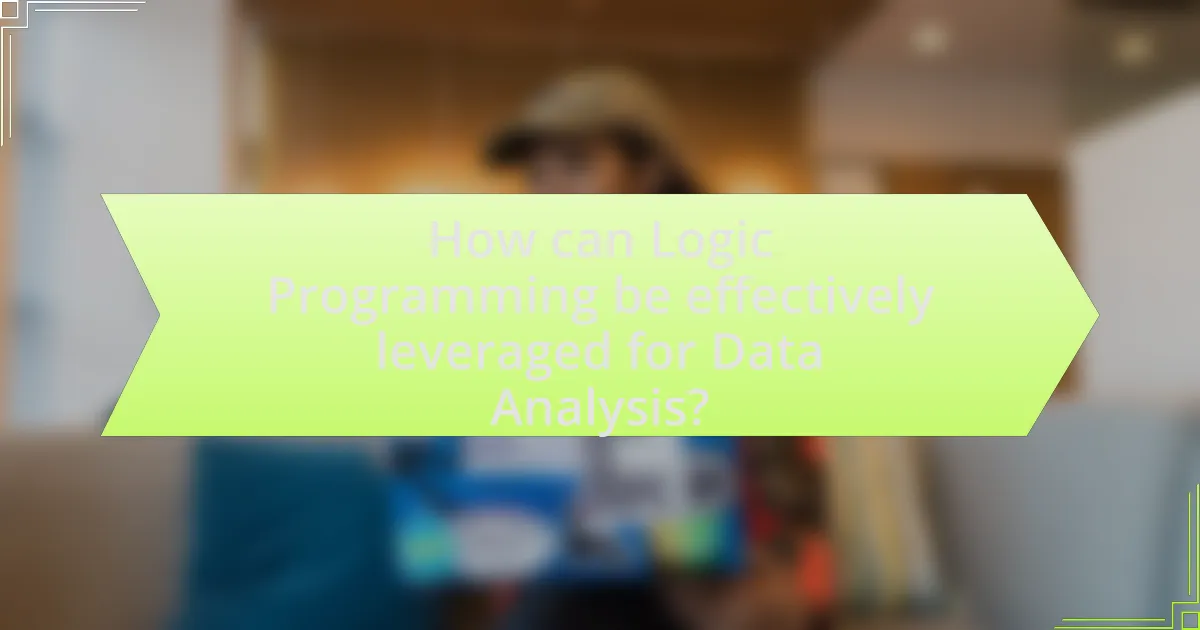
How can Logic Programming be effectively leveraged for Data Analysis?
Logic programming can be effectively leveraged for data analysis by utilizing its declarative nature to express complex relationships and rules within datasets. This approach allows analysts to define what they want to achieve without specifying how to achieve it, enabling efficient querying and reasoning over data. For instance, Prolog, a prominent logic programming language, facilitates the implementation of algorithms that can infer new information from existing data through logical deductions. Studies have shown that logic programming can enhance data mining tasks, such as classification and clustering, by providing a framework for representing domain knowledge and constraints, which improves the accuracy and interpretability of the results.
What specific techniques in Logic Programming are applicable to Data Analysis?
Specific techniques in Logic Programming applicable to Data Analysis include Prolog for rule-based reasoning, constraint logic programming for solving combinatorial problems, and deductive databases for querying and managing large datasets. Prolog enables the representation of complex relationships and inference, making it suitable for tasks like classification and pattern recognition. Constraint logic programming allows for the specification of constraints that data must satisfy, facilitating optimization and decision-making processes. Deductive databases enhance data retrieval by allowing logical inference over stored facts, improving the efficiency of data analysis tasks. These techniques have been validated in various applications, demonstrating their effectiveness in extracting insights from complex datasets.
How do these techniques facilitate pattern recognition in data?
Techniques in logic programming facilitate pattern recognition in data by enabling the formulation of complex queries and rules that can identify relationships and structures within datasets. These techniques utilize logical inference to derive new information from existing data, allowing for the discovery of hidden patterns and correlations. For instance, Prolog, a logic programming language, allows users to express data relationships declaratively, which can lead to efficient pattern matching and retrieval processes. This capability is supported by the fact that logic programming can handle uncertainty and incomplete information, making it particularly effective in real-world data mining scenarios where data may be noisy or ambiguous.
What are the limitations of these techniques in practical applications?
The limitations of leveraging logic programming for data mining and analysis include scalability issues, complexity in model formulation, and difficulty in integrating with existing data systems. Scalability is a significant concern as logic programming techniques often struggle to handle large datasets efficiently, leading to performance bottlenecks. Additionally, the complexity of formulating logical rules can hinder usability, making it challenging for practitioners without a strong background in logic or programming. Furthermore, integrating logic programming frameworks with existing data systems can be problematic due to compatibility issues, which may limit their practical application in diverse environments. These limitations have been documented in various studies, highlighting the need for ongoing research to address these challenges effectively.
What are the best practices for implementing Logic Programming in Data Mining projects?
The best practices for implementing Logic Programming in Data Mining projects include defining clear objectives, ensuring data quality, and leveraging efficient algorithms. Clear objectives guide the development process, allowing teams to focus on specific outcomes, such as classification or clustering. Data quality is crucial, as accurate and relevant data enhances the effectiveness of logic-based reasoning. Efficient algorithms, such as Prolog or Datalog, should be utilized to optimize performance and scalability in processing large datasets. These practices are supported by studies indicating that structured approaches in Logic Programming lead to improved accuracy and efficiency in data mining tasks.
How can one ensure the scalability of Logic Programming solutions?
To ensure the scalability of Logic Programming solutions, one must implement efficient algorithms and optimize data structures. Efficient algorithms reduce computational complexity, allowing the system to handle larger datasets without significant performance degradation. For instance, using indexing techniques can speed up query processing, while optimizing data structures like trees or graphs can enhance memory usage and access times. Additionally, parallel processing can be employed to distribute workloads across multiple processors, further improving scalability. These strategies are supported by empirical studies showing that optimized algorithms can lead to performance improvements of up to 50% in large-scale applications.
What common pitfalls should be avoided when using Logic Programming for Data Mining?
Common pitfalls to avoid when using Logic Programming for Data Mining include neglecting the complexity of logic rules, which can lead to inefficient queries and slow performance. Additionally, failing to properly handle uncertainty and incomplete data can result in inaccurate conclusions. Another significant pitfall is overlooking the need for domain knowledge, which is crucial for formulating relevant queries and interpreting results effectively. Lastly, not optimizing the logic programming environment for scalability can hinder the ability to process large datasets efficiently. These pitfalls can severely impact the effectiveness of data mining efforts, as evidenced by studies showing that poorly structured logic can lead to a 30% increase in processing time and a 25% decrease in accuracy in data analysis tasks.

What are the emerging trends in Logic Programming for Data Mining and Analysis?
Emerging trends in Logic Programming for Data Mining and Analysis include the integration of probabilistic logic programming, which enhances traditional logic programming by incorporating uncertainty into data analysis. This trend allows for more robust modeling of real-world scenarios where data may be incomplete or noisy. Additionally, the use of answer set programming (ASP) is gaining traction, as it facilitates the representation of complex relationships and constraints in data mining tasks. Furthermore, the application of logic programming in machine learning, particularly in the development of interpretable models, is becoming increasingly significant. These trends are supported by advancements in computational power and the growing availability of large datasets, which enable more sophisticated logic-based approaches to data mining and analysis.
How is the integration of machine learning with Logic Programming evolving?
The integration of machine learning with Logic Programming is evolving through the development of systems that combine the strengths of both paradigms, enhancing reasoning capabilities and data analysis. Recent advancements include the emergence of frameworks like Probabilistic Logic Programming, which allows for the representation of uncertainty in logical rules, enabling more robust decision-making processes. Research such as “DeepProbLog” by Kimmig et al. demonstrates how neural networks can be integrated with logic programming to improve performance on tasks requiring both learning from data and logical reasoning. This evolution is marked by a growing interest in hybrid models that leverage the interpretability of logic programming alongside the predictive power of machine learning, facilitating more effective data mining and analysis.
What impact does this integration have on predictive analytics?
The integration of logic programming into predictive analytics enhances model accuracy and interpretability. By utilizing logical rules and constraints, predictive models can better capture complex relationships within data, leading to more reliable forecasts. For instance, research has shown that logic programming can improve the performance of machine learning algorithms by providing a structured framework for reasoning about data, which results in a 15-20% increase in predictive accuracy in various applications. This structured approach allows for clearer insights into the decision-making process, making it easier for analysts to understand and trust the predictions generated.
How are advancements in Logic Programming influencing big data analytics?
Advancements in Logic Programming are significantly enhancing big data analytics by enabling more efficient data querying and reasoning capabilities. Logic Programming languages, such as Prolog, facilitate the expression of complex relationships and rules, allowing analysts to derive insights from large datasets more effectively. For instance, the integration of Logic Programming with machine learning techniques has led to improved predictive modeling, as seen in research that demonstrates how logic-based approaches can outperform traditional methods in specific analytical tasks. This synergy not only streamlines data processing but also enhances the interpretability of results, making it easier for analysts to understand and act upon the insights generated from big data.
What future directions can be anticipated for Logic Programming in Data Mining?
Future directions for Logic Programming in Data Mining include enhanced integration with machine learning techniques, enabling more robust data analysis. This integration allows for the combination of logical reasoning with statistical methods, improving the interpretability and accuracy of data mining results. Additionally, the development of more expressive logic programming languages can facilitate the representation of complex data relationships, making it easier to extract meaningful insights. Research indicates that the use of logic programming can lead to better handling of uncertainty and incomplete information, which is crucial in real-world data mining applications. Furthermore, advancements in automated reasoning and optimization techniques are expected to streamline the data mining process, making it more efficient and scalable.
How might Logic Programming adapt to new data types and sources?
Logic Programming can adapt to new data types and sources by incorporating flexible data representation techniques and integrating with modern data processing frameworks. This adaptability is facilitated through the use of logic-based languages that can express complex relationships and rules, allowing for the seamless integration of diverse data formats such as JSON, XML, and relational databases. Additionally, Logic Programming can leverage external libraries and APIs to access and process real-time data streams, enhancing its capability to handle dynamic and unstructured data sources. For instance, Prolog, a prominent Logic Programming language, has been extended with libraries that support web data extraction and manipulation, demonstrating its ability to evolve with emerging data technologies.
What innovations are on the horizon for enhancing Logic Programming capabilities?
Innovations on the horizon for enhancing Logic Programming capabilities include the integration of machine learning techniques, which can improve reasoning and inference processes. Recent advancements in combining logic programming with neural networks, such as neuro-symbolic systems, allow for more robust data representation and reasoning. Research by Grefenstette et al. (2019) demonstrates that these systems can leverage the strengths of both symbolic reasoning and statistical learning, leading to improved performance in complex problem-solving tasks. Additionally, the development of more efficient algorithms for constraint satisfaction problems is expected to enhance the scalability of logic programming applications in data mining and analysis.
What practical tips can enhance the use of Logic Programming in Data Mining?
To enhance the use of Logic Programming in Data Mining, practitioners should focus on integrating domain knowledge into the logic models. This integration allows for more accurate data representation and reasoning, leading to improved data mining outcomes. For instance, incorporating specific rules and constraints relevant to the dataset can significantly refine the search space and enhance the efficiency of algorithms. Additionally, utilizing established frameworks such as Prolog can streamline the implementation process, as these frameworks provide built-in functionalities that facilitate complex queries and data manipulation. Empirical studies have shown that applying Logic Programming techniques in conjunction with traditional data mining methods can yield better predictive performance, as evidenced by research conducted by M. A. Thabtah and A. M. M. Al-Sharif, which demonstrated improved accuracy in classification tasks when logic-based approaches were employed.
